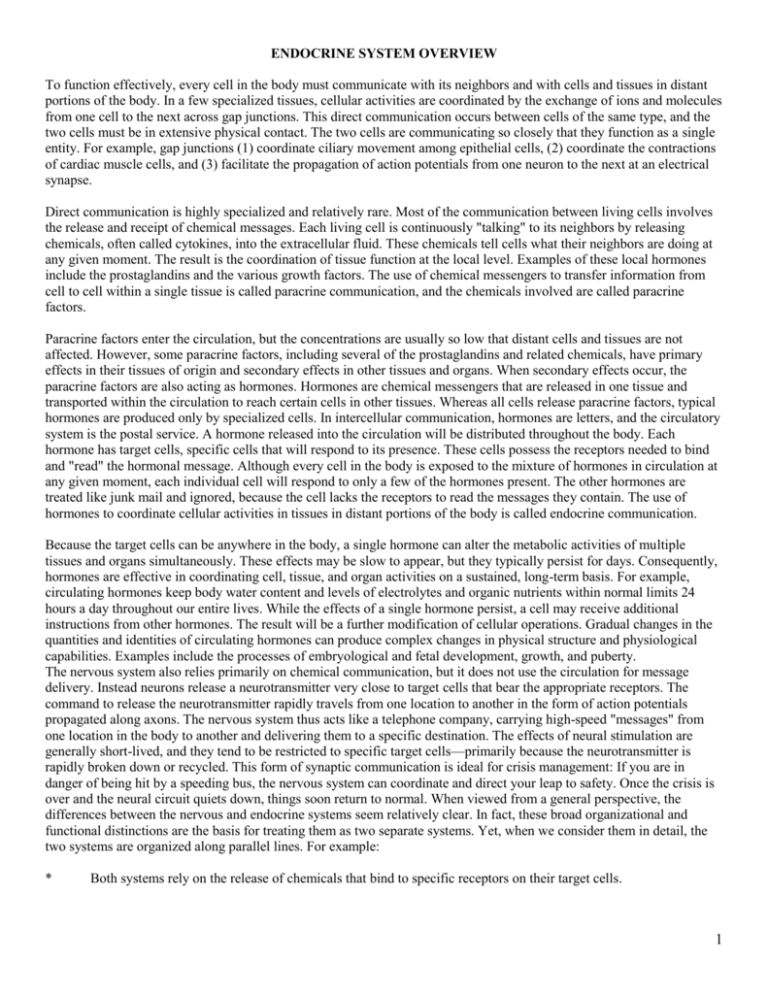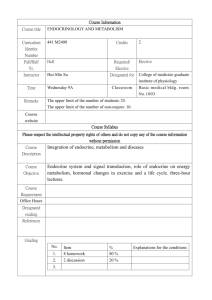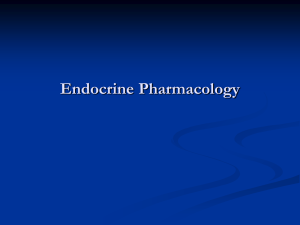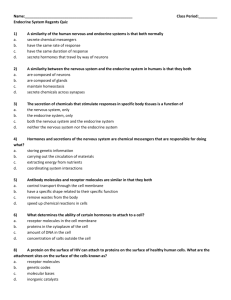Chapter 23 - Angelo State University
advertisement

ENDOCRINE SYSTEM OVERVIEW To function effectively, every cell in the body must communicate with its neighbors and with cells and tissues in distant portions of the body. In a few specialized tissues, cellular activities are coordinated by the exchange of ions and molecules from one cell to the next across gap junctions. This direct communication occurs between cells of the same type, and the two cells must be in extensive physical contact. The two cells are communicating so closely that they function as a single entity. For example, gap junctions (1) coordinate ciliary movement among epithelial cells, (2) coordinate the contractions of cardiac muscle cells, and (3) facilitate the propagation of action potentials from one neuron to the next at an electrical synapse. Direct communication is highly specialized and relatively rare. Most of the communication between living cells involves the release and receipt of chemical messages. Each living cell is continuously "talking" to its neighbors by releasing chemicals, often called cytokines, into the extracellular fluid. These chemicals tell cells what their neighbors are doing at any given moment. The result is the coordination of tissue function at the local level. Examples of these local hormones include the prostaglandins and the various growth factors. The use of chemical messengers to transfer information from cell to cell within a single tissue is called paracrine communication, and the chemicals involved are called paracrine factors. Paracrine factors enter the circulation, but the concentrations are usually so low that distant cells and tissues are not affected. However, some paracrine factors, including several of the prostaglandins and related chemicals, have primary effects in their tissues of origin and secondary effects in other tissues and organs. When secondary effects occur, the paracrine factors are also acting as hormones. Hormones are chemical messengers that are released in one tissue and transported within the circulation to reach certain cells in other tissues. Whereas all cells release paracrine factors, typical hormones are produced only by specialized cells. In intercellular communication, hormones are letters, and the circulatory system is the postal service. A hormone released into the circulation will be distributed throughout the body. Each hormone has target cells, specific cells that will respond to its presence. These cells possess the receptors needed to bind and "read" the hormonal message. Although every cell in the body is exposed to the mixture of hormones in circulation at any given moment, each individual cell will respond to only a few of the hormones present. The other hormones are treated like junk mail and ignored, because the cell lacks the receptors to read the messages they contain. The use of hormones to coordinate cellular activities in tissues in distant portions of the body is called endocrine communication. Because the target cells can be anywhere in the body, a single hormone can alter the metabolic activities of multiple tissues and organs simultaneously. These effects may be slow to appear, but they typically persist for days. Consequently, hormones are effective in coordinating cell, tissue, and organ activities on a sustained, long-term basis. For example, circulating hormones keep body water content and levels of electrolytes and organic nutrients within normal limits 24 hours a day throughout our entire lives. While the effects of a single hormone persist, a cell may receive additional instructions from other hormones. The result will be a further modification of cellular operations. Gradual changes in the quantities and identities of circulating hormones can produce complex changes in physical structure and physiological capabilities. Examples include the processes of embryological and fetal development, growth, and puberty. The nervous system also relies primarily on chemical communication, but it does not use the circulation for message delivery. Instead neurons release a neurotransmitter very close to target cells that bear the appropriate receptors. The command to release the neurotransmitter rapidly travels from one location to another in the form of action potentials propagated along axons. The nervous system thus acts like a telephone company, carrying high-speed "messages" from one location in the body to another and delivering them to a specific destination. The effects of neural stimulation are generally short-lived, and they tend to be restricted to specific target cells—primarily because the neurotransmitter is rapidly broken down or recycled. This form of synaptic communication is ideal for crisis management: If you are in danger of being hit by a speeding bus, the nervous system can coordinate and direct your leap to safety. Once the crisis is over and the neural circuit quiets down, things soon return to normal. When viewed from a general perspective, the differences between the nervous and endocrine systems seem relatively clear. In fact, these broad organizational and functional distinctions are the basis for treating them as two separate systems. Yet, when we consider them in detail, the two systems are organized along parallel lines. For example: * Both systems rely on the release of chemicals that bind to specific receptors on their target cells. 1 * The two systems share many chemical messengers; for example, norepinephrine and epinephrine are called hormones when released into the circulation but neurotransmitters when released across synapses. * Both systems are regulated primarily by negative feedback control mechanisms. * The two systems share a common goal: to preserve homeostasis by coordinating and regulating the activities of other cells, tissues, organs, and systems. AN OVERVIEW OF THE ENDOCRINE SYSTEM CONT.: The endocrine system includes all the endocrine cells and tissues of the body. They include the hypothalamus, pituitary glands, thyroid gland, thymus gland, adrenal glands, pineal gland, parathyroid glands, pancreas, testes, ovaries, the digestive tract, the kidney, and even the heart. Some of these organs, such as the pituitary gland, have endocrine secretion as a primary function; others, such as the pancreas, ovaries, kidneys and heart, have other functions in addition to their endocrine secretion. Regardless though the endocrine cells contained in each are glandular secretory cells that release their secretions into the extracellular fluid. This characteristic distinguishes them from exocrine cells, which secrete their products onto epithelial surfaces, generally by way of ducts. The chemicals released by endocrine cells may affect only adjacent cells, as in the case of most paracrine factors, or they may affect cells throughout the body. Hormone Distribution and Transport: Hormone release typically occurs where capillaries are abundant, and the hormones quickly enter the circulation for distribution throughout the body. Within the blood, hormones may circulate freely, or they may be bound to special carrier proteins. A freely circulating hormone remains functional for less than 1 hour, and sometimes for as little as 2 minutes. It is inactivated when (1) it diffuses out of the bloodstream and binds to receptors in target tissues, (2) it is absorbed and broken down by cells of the liver or kidneys, or (3) it is broken down by enzymes in the plasma or interstitial fluids. Thyroid hormones and steroid hormones remain in the circulation much longer, because when these hormones enter the bloodstream, almost all of them become attached to special transport proteins. Less than 1 percent of these hormones circulate freely. An equilibrium state exists between the free hormones and the bound hormones; as the free hormones are removed and inactivated, they are replaced by the release of bound hormones. Thus the circulation contains a substantial reserve (several weeks' supply) of these hormones at any time. Hormone Function and Mechanisms of Action: All cellular structures and functions depend on proteins. Structural proteins determine the general shape and internal structure of a cell, and enzymes affect its metabolic activities. Hormones alter cellular operations by changing the types, activities, or quantities of important enzymes and structural proteins. In other words, a hormone may: * Stimulate the synthesis of an enzyme or a structural protein not already present in the cytoplasm by activating appropriate genes in the nucleus. * Turn an existing enzyme "on" or "off" by changing its shape or structure. * Increase or decrease the rate of synthesis of a particular enzyme or other protein by changing the rate of transcription or translation. Through one or more of these mechanisms, a hormone can modify the physical structure or biochemical properties of its target cells. To affect a target cell, a hormone must first interact with an appropriate receptor. Each cell has the receptors needed to respond to several different hormones, but cells in different tissues have different combinations of receptors. This arrangement accounts for the differential effects of hormones on specific tissues. For every cell, the presence or absence of a specific receptor determines the cell's hormonal sensitivities. If the cell has a receptor that will bind a particular hormone, that cell will respond to the hormone's presence. If the cell lacks the proper receptor for that hormone, the hormone will have no effect. Hormone receptors are located either (1) on the cell membrane or (2) inside the cell. Control of Endocrine Activity: As noted earlier, there are many functional parallels between the organization of the nervous and endocrine systems. For example we considered the basic operation of neural reflex arcs, the simplest organizational units in the nervous system. The most direct arrangement was a monosynaptic reflex, such as the stretch 2 reflex. Polysynaptic reflexes provide more complex and variable responses to stimuli, and higher centers, which integrate multiple inputs, can facilitate or inhibit these reflexes as needed. Endocrine Reflexes: Endocrine reflexes are the functional counterparts of neural reflexes. They can be triggered by (1) humoral stimuli (changes in the composition of the extracellular fluid), (2) hormonal stimuli (the arrival or removal of a specific hormone), or (3) neural stimuli (the arrival of neurotransmitter at neuroglandular junctions). In most cases, endocrine reflexes are controlled by negative feedback mechanisms: A stimulus triggers the production of a hormone whose direct or indirect effects reduce the intensity of the stimulus. Endocrine cells in a simple endocrine reflex involve only one hormone. The endocrine cells involved respond directly to changes in the composition of the extracellular fluid. The secreted hormone adjusts the activities of target cells and restores homeostasis. Simple endocrine reflexes control hormone secretion by the heart, pancreas, parathyroid gland, and digestive tract. More-complex endocrine reflexes involve one or more intermediary steps and two or more hormones. The hypothalamus, the highest level of endocrine control, integrates the activities of the nervous and endocrine systems. 3







